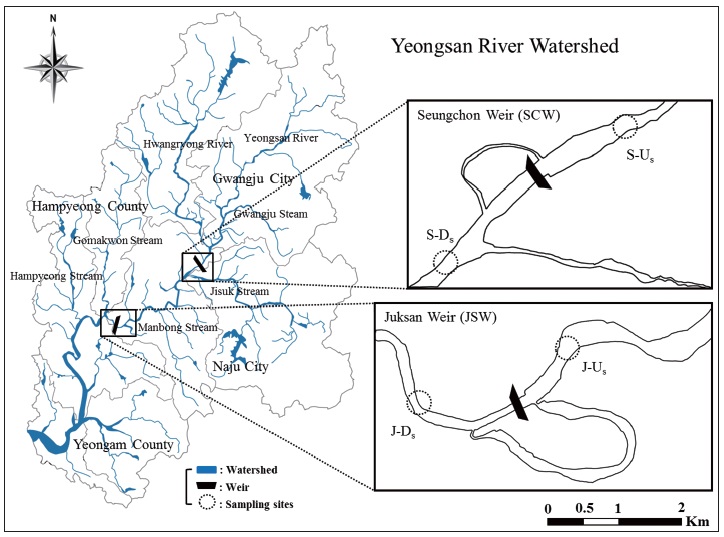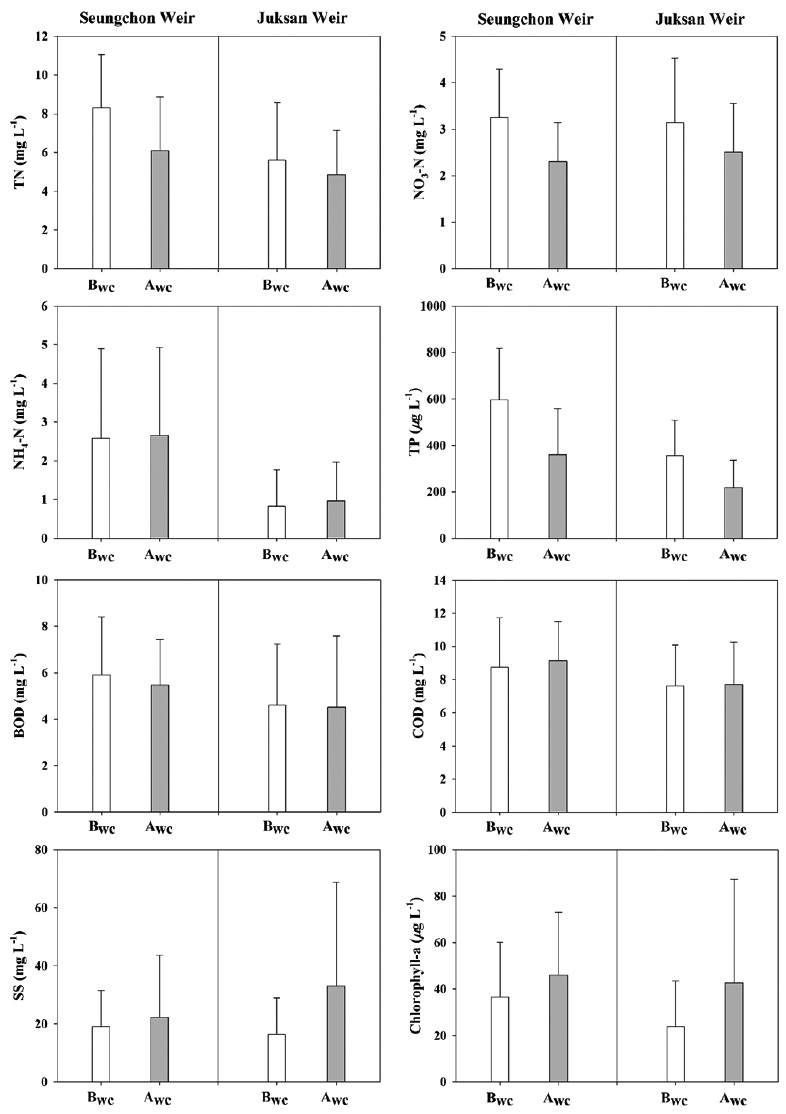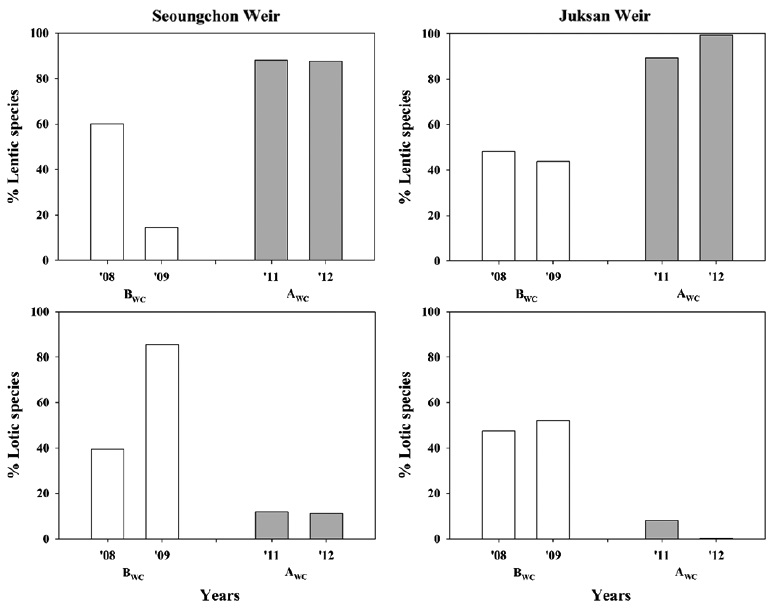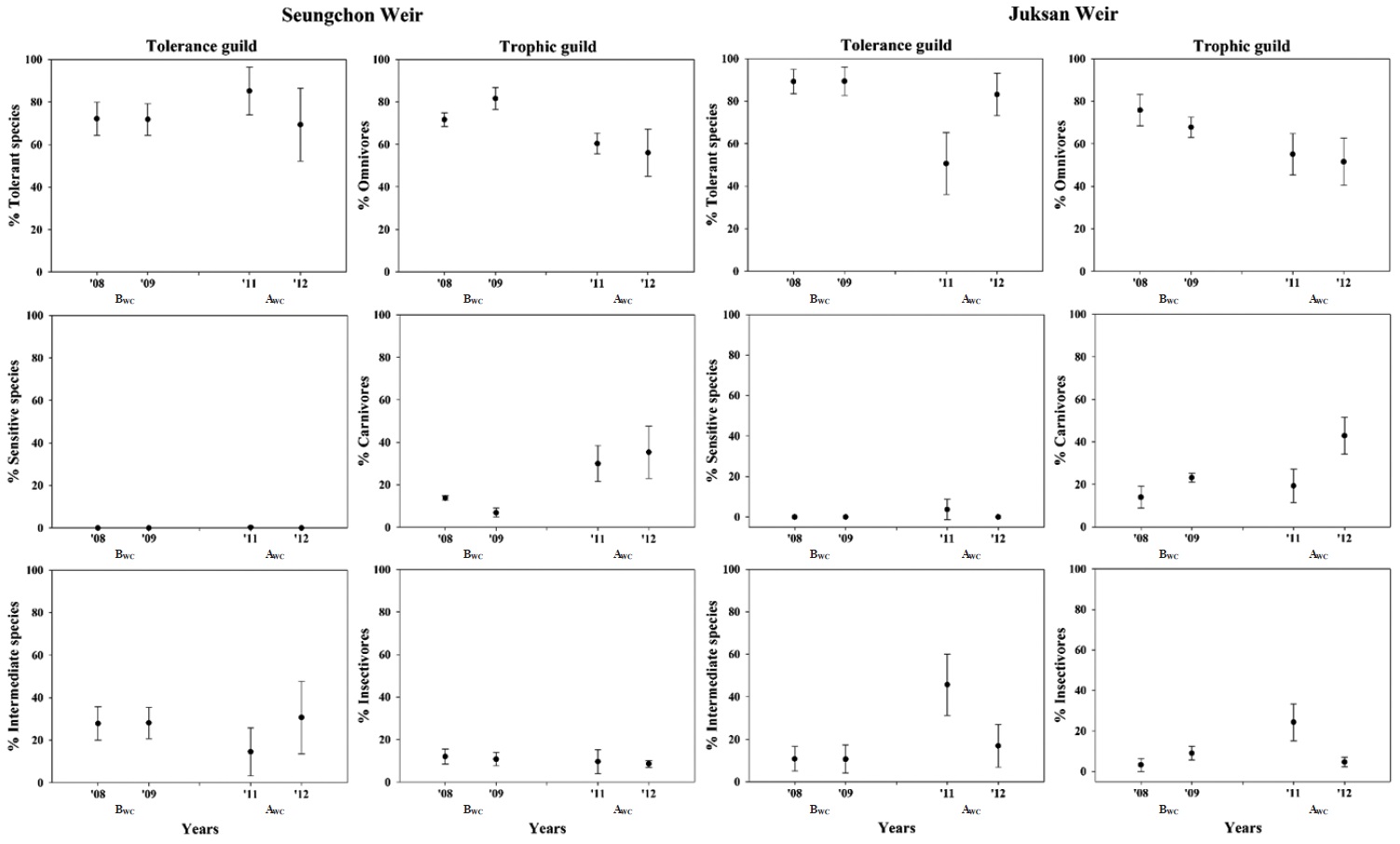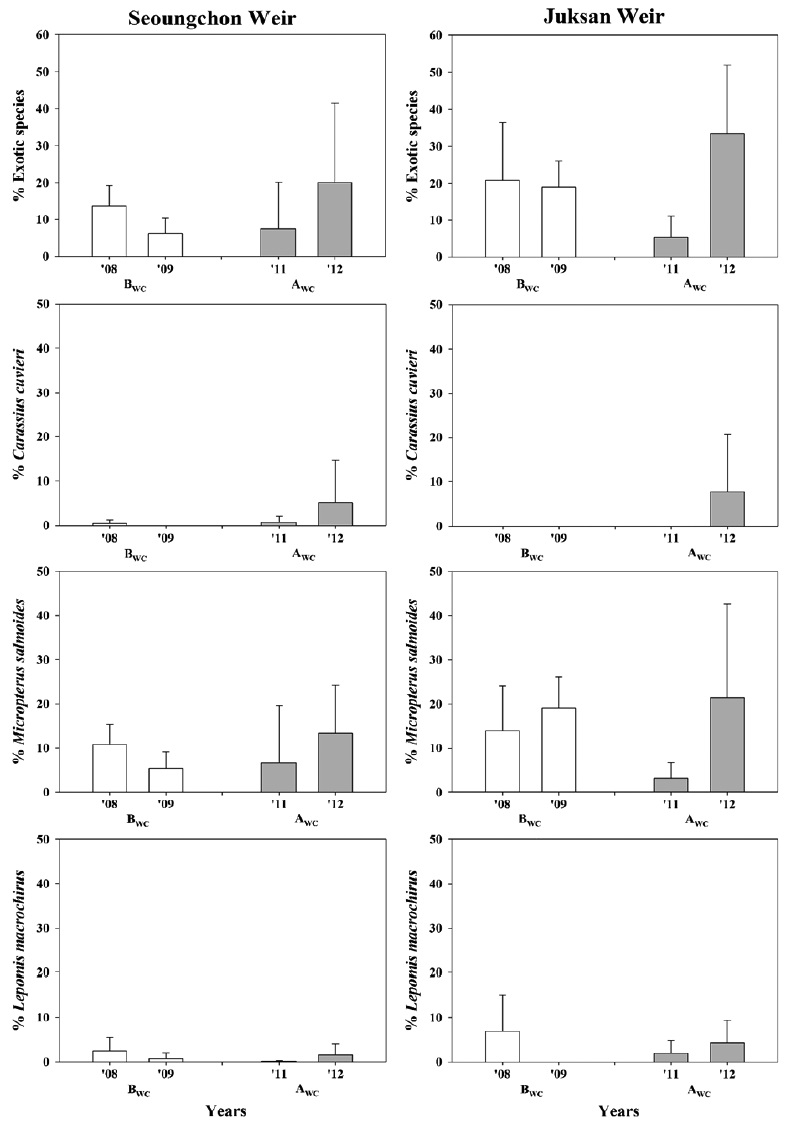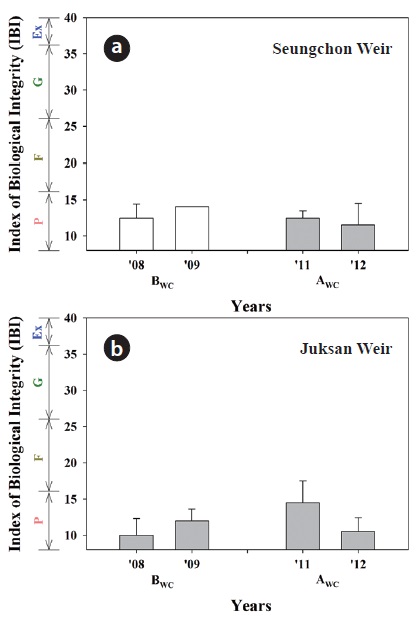



Constructions of weir or dams on the lower parts of the streams and rivers can cause longer water residence time and modifications of physical habitat structures, resulting in modifications of chemical regimes (N, P). These factors directly or indirectly affect fish communities and other biota (Poff et al. 1977, Gorman and Karr 1978). Such ecological impacts are largely demonstrated by Serial Discontinuity Concept (SDC), which was developed by Ward and Stanford (1983) in river research. Some reasons for the decline of some fish populations (i.e., sensitive species or riffle-dwelling species) and modifications of fish community structures (Schlosser 1982, Jurajda 1995) may be related with channelization, the destructions of riparian zone, and submerged vegetation during the weir or dam constructions. The biggest impacts of numerous causes by the weir constructions are frequently a barrier (obstacle) effect of fish migration (Lucas and Frear 1997).
The ecological impacts of freshwater fish on weir or small dam constructions are widely reported in USA (Holmquist et al. 1998), Canada (Townsend 1975), United Kingdom (Lucas and Frear 1997), Norway (Fjellheim and Raddum 1996), Sweden (Rivinoja et al. 2001), and Australia (Gehrke et al. 1995, 2002). These studies pointed out that various impacts of fish may be related to the weir constructions. Water quality was degraded rapidly due to accumulations of nutrients and sediments along with modifications of physical habitats for fish. In addition, water volume is considerably reduced during the dry season, so the water quality and quantity in the downstream may be dramatically changed. Also, higher residence time in the upstream region of the weir increase phytoplankton growth or algal bloom at a given nutrients (N, P). Under the circumstances, even the riverine fish adapted to fast current may be substituted into lacustrine-type fish. The trophic compositions, thus, may be modified from insectivore fish to omnivore fish due to accumulations of benthic sediments (Gorman and Karr 1978, Angermeier and Karr 1984, Poff and Allan 1995). Such conditions also may have negative impacts on the aquatic fauna and compositions after the weir constructions. The weirs could isolate partially or largely the upstream resident fish, even if the fish ways are present, and the resident species may congregate at the downstream of the weirs. Thus, the weirs on the rivers obstructed the route of the long and mid-distance migratory fish, resulting in effects of physical barrier on the migratory fish. The main problem regarding the analysis of effects of weir constructions on the river system, however, is the absence of data from the affected reach prior to the alteration (Groffman et al. 2003).
The weir construction was initiated from the Korean government’s five-year national plan of “Four Major Rivers Project” in July 2009. The government invested 17.3 billion dollars for the project. The original plan had five core objectives such as 1) securing abundant water resources to solve problems of water scarcity, 2) implementing monsoon-flood control measures, 3) improving the water quality and restoring ecological river health, 4) creating multipurpose spaces for local residents, and 5) regional cultural development centered on the rivers. The government tried to secure adequate water supply (1.3 billion m3) to prepare future water scarcity and severe drought due to global climate change. For this reason, 16 weirs were constructed in the watersheds of four major rivers and the two weirs of Seungchon Weir and Juksan Weir were constructed in the watershed of Yeongsan River. Contrary to the original purposes, numerous studies reported on some hydrological modifications (Kim et al. 2009), chemical impacts and ecological problems of algal blooms and some fish kills. One of the prominent characteristics was abrupt increases of water residence time and nutrients (N, P) along with severe surface scums and algal blooms in the upper region of the weirs. Furthermore, abrupt massive fish kills occurred in some weirs after the weir construction and thus the government worried about the deterioration of the river ecosystem. This is reason why we conducted to analyze some impacts on fish population and community structure in this study.
The objectives of the research were to compare chemical water quality and the fish community structures along with the ecosystem health before the weir construction (Bwc; 2008-2009) and after the weir construction (Awc; 2011-2012) at Juksan Weir and Seungchon Weir of Yeongsan River watershed. In addition, ecological components of trophic guilds and tolerance guilds were analyzed in the upper-reach and lower-reach of Seungchon Weir and Juksan Weir, respectively.
>
The study watershed and sampling sites
The watershed area of Yeongsan River is 3,371 km2, and the length from the headwater to estuary reaches 136 km. Major of tributaries in Yeongsan River watershed include Hwangryong River, Jisuk Stream, Gomakwon Stream, Hampyung Stream, Manbong Stream, and Gwangju Stream (Fig. 1). It is largely influenced by many nonpoint sources such as rice paddies as well as pointsource of wastewater disposal plants and sewage treatment (MEK 2012). Two artificial weirs were constructed in the midstream and downstream of the Yeongsan River in 2012. Seungchon Weir (longitude, 127˚62′92″; latitude, 35˚06′48″) and Juksan Weir (longitude, 126˚62′92″; latitude, 35˚06′48″) were constructed by the 4 major river restoration project. Seungchon Weir is 9.0m tall and 540m long in the width with control water level of 7.5m. Juksan Weir located in the downstream of Seungchon Weir and is 4.85m tall and 622m width with control water level of 3.5m.
>
Fish collections and sampling gears
Fish were collected in upstream site of each weir (S-Us / J-Us), and in downstream site of each weir (S-Ds / J-Ds). Also, all habitat types such as riffle, run, and pool were included for the fish sampling according to the approach of wading method (Ohio EPA 1989) based on the catch per unit effort (CPUE). The distance and time elapsed in the sampling was at least 200 m and 60 minutes, respectively. The sampling gears of casting net (7 × 7 mm) and kick net (4 × 4 mm) were used for the analysis of sampling sites, which are the most popular fish sampling gears in Korea. All fishes were identified at field, and released immediately. Tolerance and trophic guild analyses were based on the previous regional studies (An et al. 2002, 2004).
The habitat quality assessments on the upstream and downstream of the artificial weirs in the Yeongsan River were conducted by using the model of Qualitative Habitat Evaluation Index (QHEI). The QHEI model, based on the habitat evaluation by Barbour et al. (1999), was revised by An and Kim (2005), for regional applications and each rank per a variable value classified by the criteria of An and Kim (2005). The health conditions of the habitat were categorized as four levels such as “Excellent” (182-220), “Good” (124-168), “Fair” (66-110), and “Poor” (8-52) conditions.
Chemical water quality was analyzed at sampling sites between before (Bwc, 2008-2009) and after weir construction (Awc, 2011-2012). To evaluate how fish distribution characteristics are related to chemical water quality, various parameters such as total nitrogen (TN), nitrate nitrogen (NO3-N), ammonium nitrogen (NH4-N), total phosphorus (TP), chlorophyll-a (CHL-a), electric conductivity (EC), and suspended solids (SS) were analyzed. Also, chemical measurements of biological oxygen demand (BOD) and chemical oxygen demand (COD) were conducted by the approach of Eaton and Franson (2005).
>
Ecological health assessment model (IBI)
The ecological health of the river was evaluated by using the original approach of rapid bioassessment protocol (RBP) recently developed by Barbour et al. (1999). For the study, eight metric models of the IBI were applied, instead of original 12 metric models originally suggested by Karr (1981). The model was established by the regional application (An et al. 2002, 2004). The variable values per metric were scored by “1”, “3”, and “5”, and then was added up. The health condition was categorized as four levels such as “Excellent” (36-40), “Good” (26-35), “Fair” (16-25), and “Poor” (< 15) conditions.
>
Water quality of physiochemical parameters
Mean concentration of total nitrogen (TN) was 8.32 mgL-1 in Seungchon Weir and TN decreased by 23% after the weir construction. NO3-N had similar trend with TN (Fig. 2). Unlike the decrease of TN, NH4-N showed a slight increase and this was due to influences of livestock, fertilizers, and sewages from the watershed in the circumstance of reduced water residence time (WRT). Total phosphorus (TP) concentration was 590
Before the construction of Juksan Weir, TN was averaged 5.60 mgL-1, while after the construction TN was decreased to 13%. The water quality in Juksan Weir declined less than it in Seungchon Weir. Concentrations of NO3-N and NH4-N in Juksan Weir, however, were similar to them in Seungchon Weir (Fig. 2). Concentrations of TP were averaged to 350
The first change of this water body stretched out the weir construction sites in the midstream and downstream of the mainstream in the Yeongsan River. More than 50% of the mid-area was used as farmlands, forests and fields, and fisheries. The tributaries such as Hwangryong River, Gwangju Stream, Gomakwon Stream, Jisuk Stream, Manbong Stream joined to the mainstream, and they were vulnerable from the pollutant source. Thus, the tributaries had the serious eutrophication (Kang and An 2006). This vulnerable ecological environment in the river are variables in barrier effect by the weir construction.
>
Shifts of species compositions
During the study period, total 6 families and 28 species were collected in the sampling sites. Total numbers of fish species sampled were 23 for 1,803 individuals and 23 for 797 individuals in Seoungchon Weir and Juksan Weir, respectively. The population of
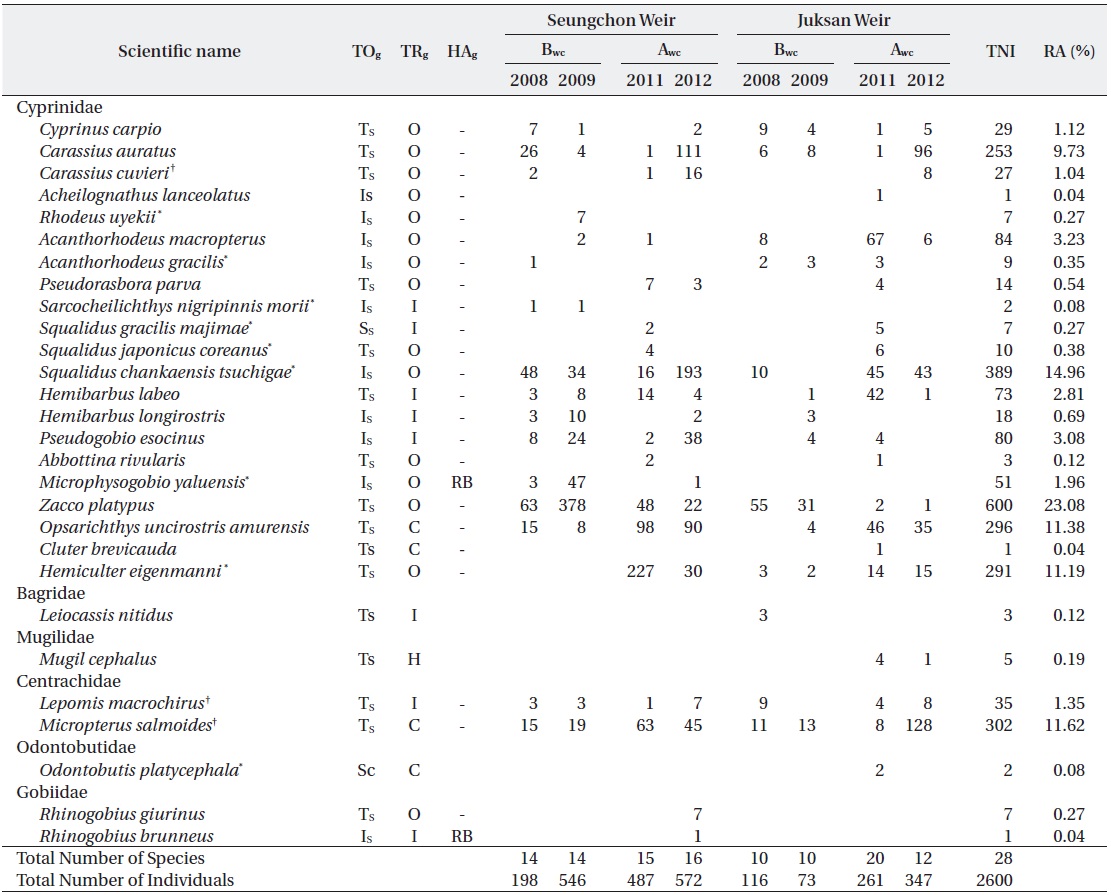
Fish fauna and its relative abundance (RA) along with tolerance guilds (TOg) and trophic guilds (TRg) before- and after-the weir construction in two artificial weirs
>
Characteristics of tolerance guilds
According to the analysis of the fish tolerance guild, tolerant species increased from 72% at Bwc to 77% at Awc and intermediate species decreased from 28% at Bwc to 23% at Awc in Seungchon Weir. According to guild researches of Karr (1981) and Klemm et al. (1993), the number of individuals and species in tolerant species increased with degradations of chemical water quality. Such condition made tolerant species dominant in the Yeongsan River (Fig. 4). After the weir construction in Juksan weir, tolerant species decreased from 89% at Bwc to 67% at Awc and intermediate species increased from 11% at Bwc to 31% at Awc. It indicate that tolerant species declined and intermediate sharply increased.
In 2012, sensitive species were rare in both weirs (Fig. 4). In the above analysis, it was different from the general phenomenon in the upstream and downstream of the river. It should be attentive and observed if it was transitional phenomenon by the construction or if there were another factors. The factor that sensitive species emerged in both areas in 2011 was also considered to be caused by dredging river bed in the temporary water environment. According to the Yeongsan River research report, sensitive species emerged in the integrated areas of the mainstream and the tributaries. The case study site of this research was the mainstream. The differences of the emerged species showed how poor the aquatic environment was. After the weir construction, they decreased by about 20% - 25% in the Yeongsan River (including the mainstream and tributaries). There were only 0.1% of emergence in tolerant species and sensitive species. It showed the past and present environment in the Yeongsan River.
>
Trophic compositions and some impacts
According to the trophic guild analysis, before the weir construction, 9 species of omnivore species and 5 species of insectivore species were collected in Seungchon Weir (Table 1). Omnivore species dominated the community as 76% in the relative abundance. The Yeongsan River research (Wui et al. 1977) in 1970s reported that the numbers of omnivore and insectivore species were 14 and 15, respectively. After the weir construction, the numbers of omnivore and insectivore species increased to be 20 and 16, respectively, but since the relative abundance (RA) of carnivore species obviously increased by 33%, RA of omnivore species rather declined. According to the research by Barbour et al. (1999), the increase of stream order brought about the inflow of organic matter and the toxic material in the aquatic ecosystem that makes the simple trophic structure and ecosystem health worse.
Before the weir construction in Juksan Weir, omnivore and insectivore species were 7 and 5, respectively (Table 1). After the weir construction, 12 omnivore species and 4 insectivore species were collected. Omnivore species was 53% and carnivore species was 15% in the relative abundance. This research shows that omnivore species decreased and insectivore doubled can be interpreted that the water environment was improved. But the change of the downstream by the weir construction should be observed. Carnivore species increased by 31% which was 1.7 times. It showed the transitional ecological characteristics which interacts with the other environmental factors.
Mann-Whitney U-test was carried out to evaluate the characteristics in trophic guilds by the weir construction statistically. Its result shows that except for insectivore species, omnivore species (
>
Compositional modifications of exotic species compositions
Previous report of Yeongsan River showed that exotic species did not exist before the 1970s (Wui et al. 1977). Two exotics of
>
Physical habitat evaluations
After the weir construction in 2011, the mean of Qualitative Habitat Evaluation Index (QHEI) was 65 in Seungchon Weir and the mean of QHEI was 111 in Juksan Weir. The physical habitat was in the “fair” condition. The result of the each section was that the average value was 45 in the “poor” condition in the downstream of Seungchon Weir, and it was 132 in the “fair” condition in the downstream of Juksan Weir (Table 2). Overall, the differences between upstream and downstream in Seungchon Weir and Juksan Weir were found in the areas influenced by the water flow, dredging of river bed, and the channelization of the river. It would cause the quality deterioration of the habitat, and to make the abundance and diversity of the species decrease. The simplification by the specific species dominance might take place.
[Table 2.] Qualitative Habitat Evaluation Index (QHEI) at four sampling sites in Yeongsan River
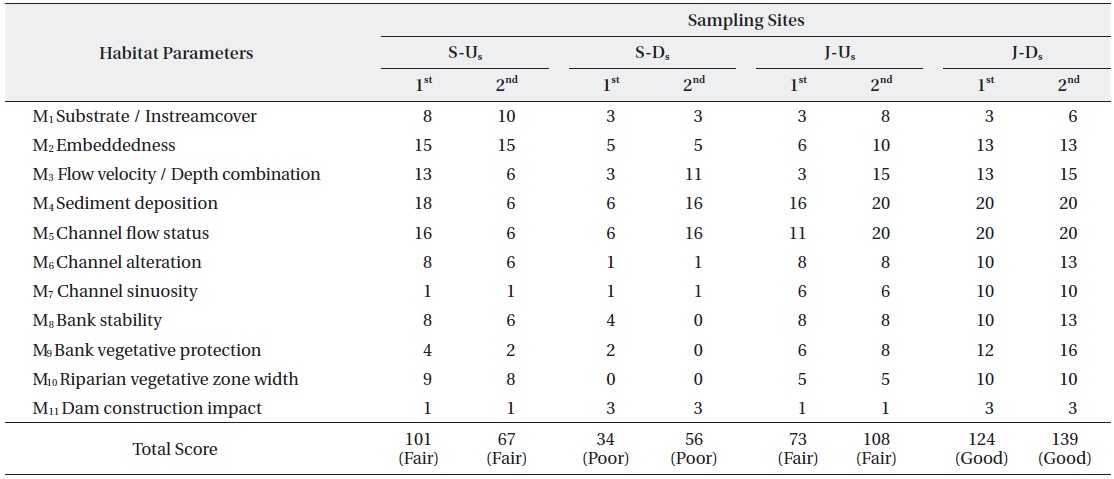
Qualitative Habitat Evaluation Index (QHEI) at four sampling sites in Yeongsan River
>
Assessments of IBI in Seungchon Weir and Juksan Weir
The model value of IBI was evaluated in Seungchon Weir and Juksan Weir between Bwc (2008-2009) and Awc (2011-2012). In the total assessment, the two sites were under 15 in the poor state (Fig. 6). The model value was 13 and 12 in Seungchon Weir and Juksan Weir, respectively. There were no significant differences between the Bwc and Awc in Seungchon Weir and Juksan Weir. These results suggest that ecological health, based on the IBI, did not change during the short-term period. Long-term monitoring for the ecological health evaluations are required to detect the ecological modifications in the river.
Suspended solids and chlorophyll-a in the watershed of Yeongsan River increased after the weir construction and this is probably due to the increased WRT. This condition influenced the fish compositions. The large increase of exotic species (
